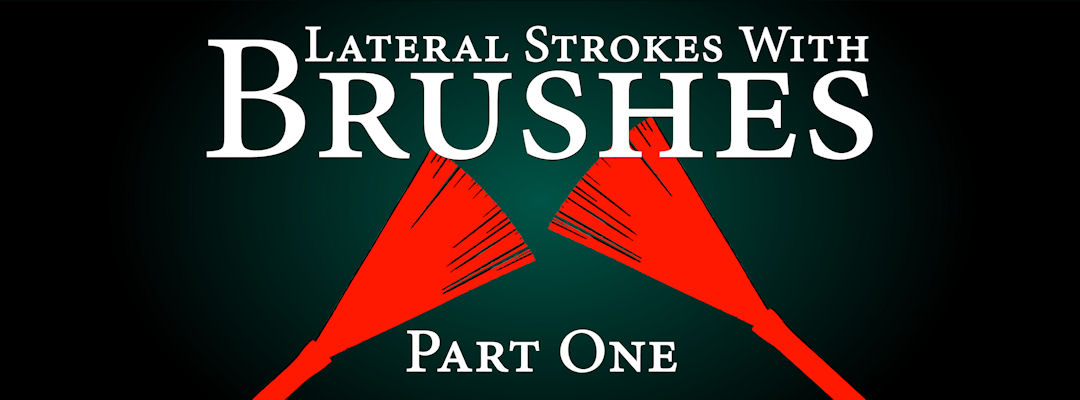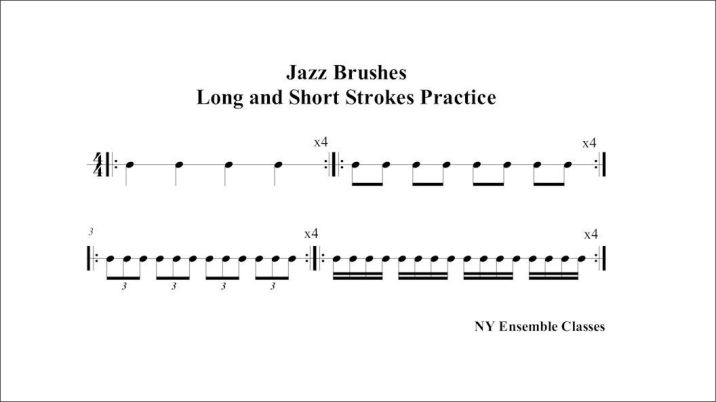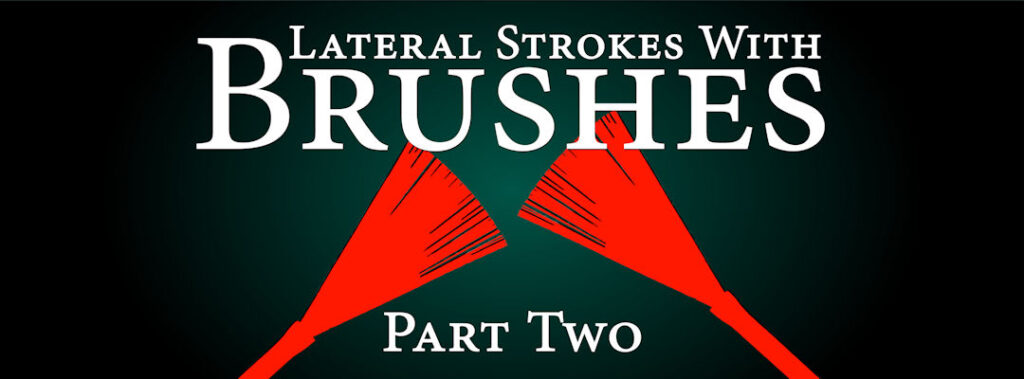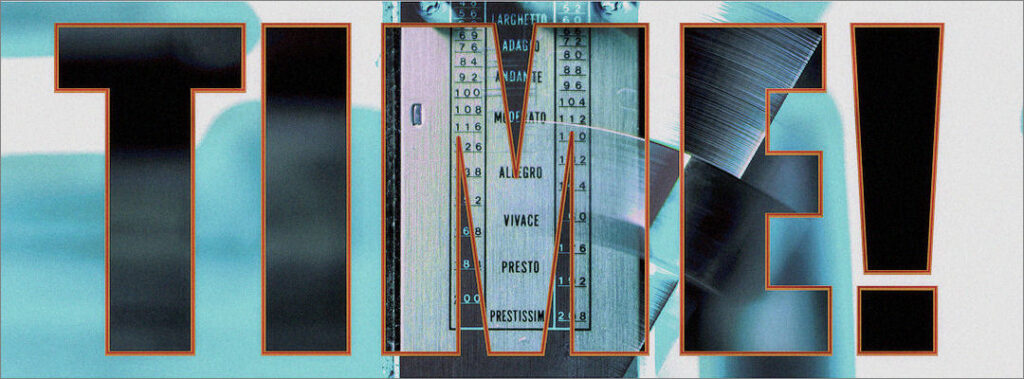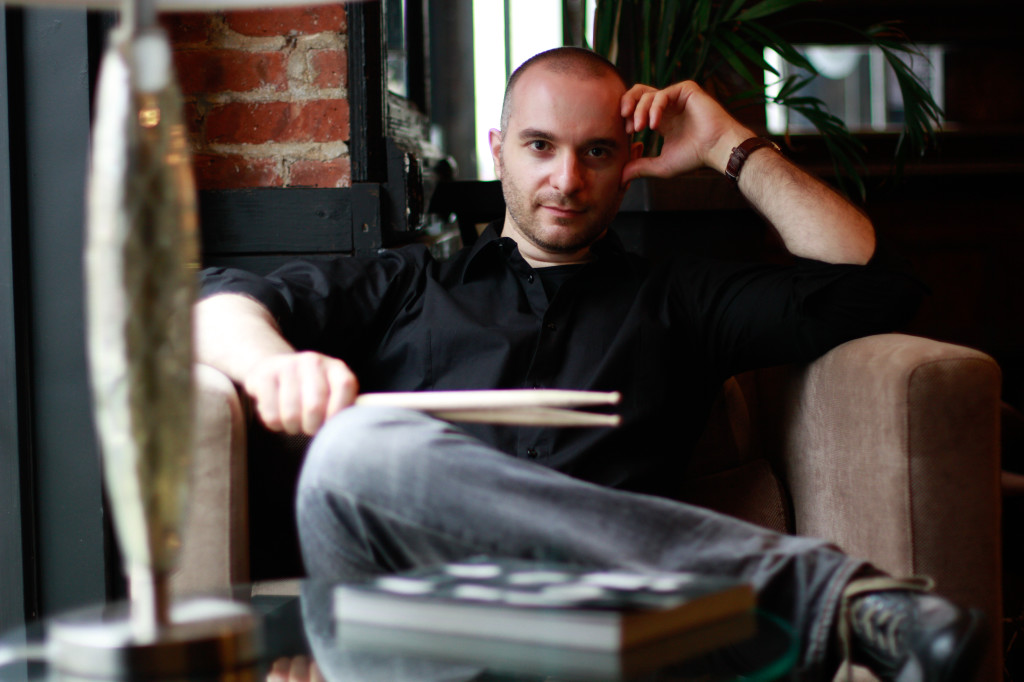(Originally posted on Feb.22, 2015 in the NYEC blog)
Becoming Familiar with Lateral Short and Long Strokes with Jazz Brushes
Back in September I wrote a post titled An Introduction to Brushes, where I examined how to produce long legato sounds using circular motions, an essential part of jazz brushes technique.
In this post I will describe another important area of brush playing: staccato sounds. The techniques that we are going to explore provide many interesting sound options, brushes have endless possibilities, and because different contexts call for different approaches, having an array of options is a good thing!
The first teacher with whom I had the opportunity to thoroughly study jazz brushes was Jon Hazilla back at Berklee. Jon is a true master, he has super solid technique and a very remarkable concept. One of the most valuable things that he shared with me was to think musically, and to translate rudimental drum technique to brushes in a way that dignifies brush playing rather than imitating stick technique. The content of this post is largely influenced by what I learned from Jon.
The Technique
When it comes to short staccato strokes, there are basically two main ways to produce them. The first is through vertical motions, which is a straight forward adaptation of stick technique (and the most common approach among drummers), the other involves lateral motions.
Lateral strokes bring an entirely different perspective into brush playing. Technically, a lateral stroke is executed by briefly letting the brush hit the drumhead as it glides across its surface. You can visualize this as a ball bouncing over a surface as it moves forward. The sound quality produced this way is different because while in a vertical stroke the wires don’t smear the surface of the head, in a lateral stroke – as brief as it can possibly be – the sound is always produced by the wires sliding over the surface of the head, which affects timbre, sustain and resonance.
The most important difference between the two approaches, though, lies in the motions. When you play lateral strokes, the start and end positions of your hands are always on the opposite sides of the drum, which opens a door to some interesting possibilities.
This video shows single short staccato strokes.
As you can see, most of the motion is in the wrists, and the strokes are played with this cycle:
- R down / inwards
- L down / inwards
- R up / outwards
- L up / outwards
Let’s take it a step further: when we look into it, we find that by extending how long the brushes slide over the head we can produce long sounds.
Long sounds are still played staccato. Technically it is possible to produce legato sounds by playing lateral long strokes without any attack, but for the purpose of this post let’s focus on playing staccato, which is the most common application of this technique.
In the videos you may have noticed that the drum head is far from new. I decided not to mount a new head because I wanted to make the point that even when the finish is worn off, it is still possible to get a sound with your brushes. I wanted to show a real scenario where there are imperfections in the sound. Drums are a profoundly analog instrument and brushes are the most analog of all percussion. The slightest imperfection on the drumhead will interact with the wires and produce a sound: this is the every-day reality of playing drums, and I believe it should be embraced.
Practice
Now that we are acquainted with these sound options, let’s explore the technique.
As you can see in the videos, the brushes are low and almost parallel to the head, that’s important for smoothness and control. I play match grip, but traditional grip works as well. Also, I play with the snare on, but that’s just a personal preference.
It is important to stay relaxed, to hold the brushes firmly but without tension and to strive for consistency: all strokes should produce an even sound. Any variations in speed and trajectory while the brushes smear the surface of the drumhead will be hearable.
In summary, practice the following exercises:
- Exercise 1 – Play short strokes.
- Spend time becoming comfortable with the motions (no need for a metronome at this point). Make sure that the motions are smooth, and that you are holding the brushes in such a way that all the wires are on the same plane with the head. If you notice that only a portion of the “fan” created by the wires is impacting the head, you need to fix your grip. Also, pay attention to what angle the brushes are in relation to the drumhead, the closer to parallel, the smoother the sound. It should be noted that the brushes will inevitably cross trajectories/paths: the one that is moving next, crosses over the other one. Refer to the video above and make sure you get those motions right. Finally, short strokes sound better when played with the tip of the brush.
- Turn on the metronome and work on speed and accuracy by playing quarter notes, eighth notes, triplets and sixteenth notes as shown in the image below. Each of them for fours bars, back and forth just like in the videos.
- Exercise 2 – Same as above, but producing long sounds.
- Note that, as opposed to short strokes, long strokes sound better when you use more of the surface of the brushes. You can achieve this by changing the angle of your brushes and lightly pushing them into the drum head.
Note that the faster the tempo the harder it is to hear the difference between these two kinds of stroke. This is due to the physics of it. At faster tempos the brushes move across the head in a much shorter time, resulting in shorter strokes. As you keep increasing speed, you will reach a point where the difference between the two is virtually inexistent.
These exercises are designed to develop proficiency with these motions. However, it is important to keep in mind that playing jazz brushes require an organic approach, and that most drummers agree that brushes sound their best when one is active on the head at any given time. Isolated short strokes can sound stingy, which may be desirable in some situations, or too harsh in others.
Staccato strokes are an important part of brush playing and when mixed with the circles technique I described in my first post they complete a painting full of textures, rhythmic possibilities, lines and colors. Experiment with this concept!

